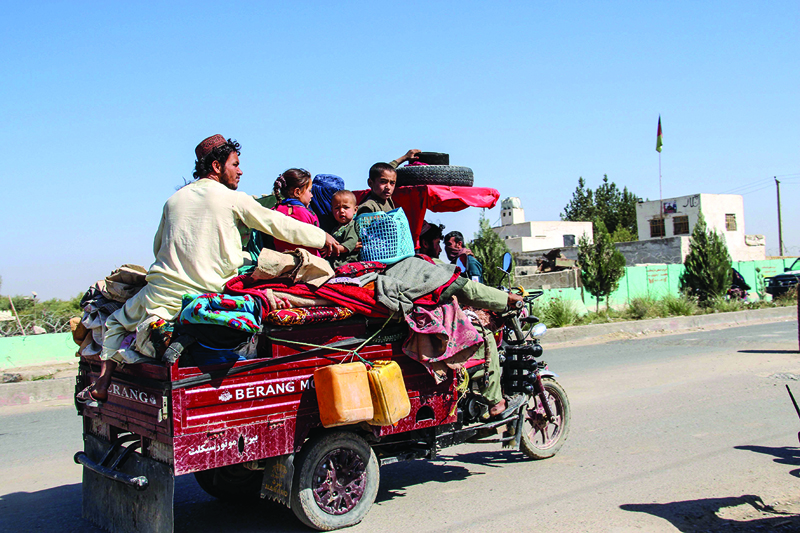
LASHKAR GAH, Afghanistan: Tens of thousands of people in southern Afghanistan have fled their homes following days of heavy fighting between the Taleban and security forces, officials said yesterday, as violence continues to soar despite ongoing peace talks.
Taleban militants launched a series of attacks on the city of Lashkar Gah in restive Helmand province on Sunday night, prompting the US to call in air strikes to defend Afghan forces. The fighting triggered an exodus by local residents who crammed onto motorcycles, taxis and buses.
"More than 5,100 families or 30,000 people… have fled the fighting so far," Sayed Mohammad Ramin, director of the refugees department in Helmand, said. "Some families are still living in the open in the streets in Lashkar Gah, we don't have tents to give them."
Local resident Hekmatullah said he was forced to flee after a mortar hit his neighbor's house, killing two women. "The fighting was so intense that I did not have time to take any extra clothes. I only took my family," said Attaullah Afghan, a farmer who fled with his family of 12.
Fighting was ongoing in at least four districts yesterday, Afghan officials said, adding that security forces have repelled repeated Taleban assaults in the area. The United Nations Assistance Mission in Afghanistan said thousands had fled and called on Taliban fighters and security forces "to take all feasible measures to protect civilians, inc. safe paths for those wishing to leave" the area.
A collision between two helicopters early yesterday in Helmand's Nawa district also killed at least nine people, according to Omar Zhwak, a spokesperson for the provincial governor. The defense ministry said they were investigating the incident. Helmand-a Taleban stronghold-is where international forces fought some of the bloodiest campaigns of Afghanistan's 19-year war.
Villagers live in fear
Living in the shadow of a US military base had provided protection to villagers in eastern Afghanistan, but locals now say the recent withdrawal of foreign troops has left them exposed to militant attacks. "When the Americans were here, there were drones in the air 24 hours a day and there were no Taliban and Islamic State," said Kameen Khan, who lives near one former US base in the Achin district of Nangarhar province. "In the months since they left the area, the Taliban and IS have restarted their activities," he told AFP.
Dozens of US special forces set up shop in Achin-and at another base in neighboring Haska Mina-to fight IS after the militants seized large parts of Nangarhar in 2015 and established a foothold in Afghanistan. For a while, the province was terrorized by jihadists, who sometimes beheaded locals or forced them to sit on bombs before detonating them.
They also destroyed health centers and forced schools to close. For many in nearby towns and villages, the US arrival provided a welcome respite: attacks dropped dramatically as drones and jets pummeled militant positions. The Pentagon focused significant resources on the area, including in 2017 when it deployed the military's largest non-nuclear weapon, the MOAB, nicknamed "Mother Of All Bombs", on an IS cave complex.
"Security got better, people were happy," said Haska Mina governor Rizwanullah Basharmal. Haji Gul Shinwari, who lives in Achin, said the American presence had meant farmers could return to their fields in relative safety. "But since they left, we cannot go outside at night, as we worry the Taleban or IS will come again," he said.
Mines shut down
Living alongside a US military base also allowed trade to flourish, and the presence of nearby troops provided some stability to industries such as talc mining. But now several nearby mines have shut down, said Hayatullah, whose relatives were involved in the extraction of the mineral used in products ranging from baby powder to paint. "Over the years, traders came here to invest in mines, but when US forces left, they too left," said Hayatullah, who like many Afghans goes by one name.
The withdrawal of US troops has been a cornerstone of US President Donald Trump's plans to end America's longest war. His administration cut a deal with the Taleban in February, promising a full troop withdrawal in exchange for a commitment from the group to stop trans-national jihadist groups such as Al-Qaeda and IS from operating in Afghanistan. Last week, Trump tweeted that all US forces in Afghanistan "should" be home by Christmas, a move that would hasten the withdrawal timeline by about four months. US forces began leaving the Achin and Haska Mina bases in November after Afghan officials declared victory over IS. The withdrawals were completed in May and July respectively.
Some limitations
During recent visits to the facilities, signs of the former American presence remained-including small stars-and-stripes flags in various rooms and US military emblems spray-painted onto walls. Afghan forces have now assumed full control but admit to some limitations. "American forces had modern equipment like drones and were controlling the area from the air," said First Lieutenant Hashmatullah, a commander of about 60 men at the Achin base. "Unfortunately we don't have those capabilities." - AFP









